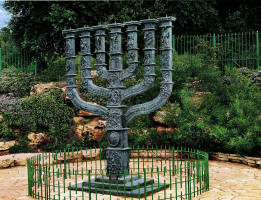
The seven-branched Menorah is a timeless symbol of faith, identity, and spiritual evolution in Judaism. From its Divine origin in the Tabernacle to its enduring role as a national symbol, it illuminates the journey to Divine unity and balance.
Historical and Religious Context
The seven-branched menorah has stood as one of the most profound religious and cultural symbols in Judaism since ancient times, symbolizing existence, identity, and the historical journey of the Jewish people. Its significance is deeply tied to the Exodus from Egypt. Built at God’s command, the menorah was crafted as a sacred furnishing of the Tabernacle (Mishkan).
Building the Sacred Space
The command
In Exodus Chapter 25, God provides Moses with a clear and detailed vision: a sacred place is to be built with all the furnishings where He may dwell among the people of Israel. This project was not just a task; it was a profound act of devotion, requiring the full engagement of the community’s skilled artisans. The most gifted among them were to contribute their talents, led by Bezalel, the son of Uri from the tribe of Judah, and supported by Oholiab, the son of Ahisamach from the tribe of Dan. Their approach was marked by extraordinary enthusiasm and a deep sense of purpose.
Material
The sacred space was to be crafted from the finest materials, each offered willingly by the people as a gift. Gold, silver, and bronze; multicolored goat wool; aromatic spices; acacia wood; and gemstones such as onyx would form the foundation of this holy endeavor. It was emphasized that all these donations must be made willingly, with no compulsion whatsoever. Everything required for building this sacred place would have to be a gift. God also described the intricate designs that would adorn this sacred place, from motifs of cups and almond blossoms to seamless, apple-like forms.
Structure
The Menorah is a central column and three branches extending outward on either side, its design embodied symmetry and intention. The structure weighed one Dirham (21.50 kilograms). For Kabbalists, the seven branches represent more than just a physical structure. They signify the seven worlds and map the principles of human evolution. Each branch stands as a representation of Divine light—a reminder of the interconnectedness between spiritual growth and the material world.

Symbolism
Gold
The Menorah (seven-branched candelabrum) consists of a central stem with three branches on each side. It was crafted as a single piece, adorned with intricate designs, and made entirely of pure gold. The use of gold in constructing certain furnishings of the sacred space carries profound symbolism. Gold, as a noble and pure element, represents majesty, splendor, and the pinnacle of human aspirations aligned with Divinity.
The Right Side Branches
The design, arrangement of the Menorah’s branches, and its unity hold deep meanings and philosophical interpretations. Each branch has its own name, unique characteristics, and conveys Divine energies. The right side branches are associated with the upper realm:
- First Branch – Abraham (חסד / Chesed): Represents kindness and hospitality. Its energy fosters love and generosity. Its associated day is Sunday, and the ruling celestial body is the Sun.
- Second Branch – Isaac (גבורה / Gevurah): Symbolizes self-restraint and discipline. Its energy conveys strength and capability. Monday is its day, and the Moon is its governing celestial body.
- Third Branch – Jacob (תפארת / Tiferet): Represents beauty, glory, and balance. Its energy reflects beauty. The associated day is Tuesday, and its celestial ruler is Mars.
The Left Side Branches
The left side branches are associated with the lower realm:
- Fourth Branch – Moshe (Moses, נצח / Netzach): Symbolizes eternity, hope, and victory. Its energy drives resilience and triumph. The associated day is Wednesday, and its celestial body is Mercury.
- Fifth Branch – Aaron (הוד / Hod): Represents greatness and flourishment. Its energy embodies sincerity and devotion. Thursday is its day, and Jupiter is its ruling celestial body.
- Sixth Branch – Joseph (יסוד / Yesod):
Symbolizes friendship and honesty. Its energy fosters integrity and loyalty. The associated day is Friday, and Venus governs it.
The Central Stem
- Middle Stem – David (מלכות / Malchut): Represents kingship and sovereignty. Its energy is faith, spirituality, understanding, and balance. The associated day is the Sabbath (Saturday), and its celestial body is Saturn. It signifies complete flourishment–unity with the Divine.
The Menorah’s seven branches form a spiritual model guiding humanity. By embodying the six principles of the side branches, individuals can ascend to the seventh—the central stem—which symbolizes the peak of spiritual maturity, or unity with Divine essence. However, this unity is achieved only when the energies of the six branches align and harmonize within the individual.
The Menorah serves as a profound spiritual blueprint, showing humanity how to achieve the highest state of balance, faith, and Divine connection through adherence to these principles.
The Eternal Symbolism of the Menorah
Jewish scholars view the seven-branched Menorah as a symbol of purity, holiness, and the creation of the world. Following the destruction of the Temple (Beit HaMikdash) and the exiles of the Jewish people (Galut), the Menorah has served as a lasting source of spiritual inspiration, a means of preserving religious values, and a beacon for reviving Jewish faith.
During the era of the Temple, the Menorah was held in great esteem and carried profound significance. At that time, Jewish scholars prohibited the creation of any Menorah that resembled the one in Solomon’s Temple.
One of the oldest known depictions of a Menorah is the stone relief carved into the Arch of Titus in Rome. Today, a replica of this Menorah has become a national symbol, adopted after the establishment of the Jewish state.
Source
Mythological Beliefs, Yosef Setareshenas


 فارسی
فارسی